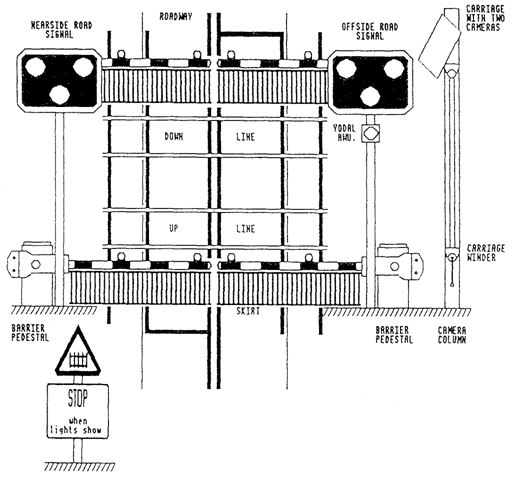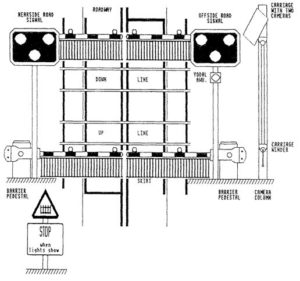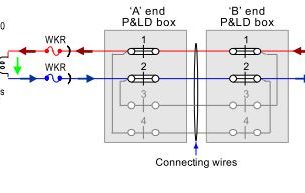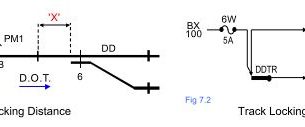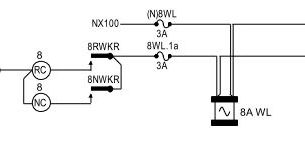Railway Level Crossings
What is Railway Level Crossings?
An intersection at the same elevation of a road footpath or bridleway and one or more rail tracks.
Strike-in point
The position on the approach to an automatic level crossing or other installation at which a train initiates the warning or closure sequence.
Warning Sequence
The order in which the visual and audible active warning devices operate as a train approaches a crossing.
Warning Time
a) The shortest time for a train to travel from the point where it is the first visible or the time when the audible warning given by a train is heard at the crossing to its arrival at the crossing – applied to a user worked crossing or a footpath crossing where whistle board is provided.
b) The shortest time for a train to travel from the strike-in point to the crossing – applied to an automatic crossing.
Decision Point
This applies to user-worked crossings, footpath crossings and bridleway crossings. It is a point where guidance on crossing safely is visible and at which a decision to cross or wait can be made in safety. For footpath crossing, this should not be less than 2m from the nearest running rails or 3m the speeds are higher than 160 Km/h. For bridleway crossings and user-worked crossings, this should not be less than 3m from the nearest running rail.
Footpath Crossing:- A public or private pedestrian level crossing.
Open Crossing:- A level crossing that has no barriers, gates or road traffic light signals and which is protected only by road traffic signs.
User-worked Crossing:- A level crossing where the user operates the crossing gates or barriers themselves.
AOCL:- Automatic open crossings, locally monitored, are equipped with road traffic light signals, but barriers are not provided. An audible warning is provided for pedestrians. New AOCL is not permitted by GI/RT7011.
Principles:- Where a right of way crosses the railway at track level, appropriate arrangements should be provided to warn and protect level crossing users, and safeguard the railway. This document also supports the HM Railway Inspectorate safety principle.
Control Measures:- The required control measures are:-
a) Barriers (lifting barriers, gates and stiles)
b) Fixed signs
c) telephones to the signaller or crossing keeper
d) active visible warnings
e) active audible warnings.
Fixed signs and road markings:-At crossing equipped with white light indicators, instruction signs bearing the words ‘caution- cross only when light shows’ shall be provided/ Also signs shall be provided to indicate the name of Level crossings, both to crossing users and to railway staff.
Active visible warnings:- Where direct observation of approaching trains at a crossing for use by railway staff is inadequate for the safety of users, warning indicators, in the form of a white light shall be provided.
Active audible warnings:- At level crossings with full barriers controlled by staff, the audible warning shall commence when the road traffic light signals are illuminated at the commencement of the barrier lowering sequence and shall cease when all barriers are fully lowered.
At all other types of crossing provided with active audible warnings, the audible warning shall commence at the initiation of the warning sequence and shall continue until all approaching trains have passed clear of the crossing. ex-AHBC. At such crossings where a second train approaches the crossing during the warning period for the first train, the audible warning shall change distinctively as soon as the first train arrives at the crossing. The number of audible devices shall not be less than two.
At footpath crossings:- it is permissible for an audible warning to be given by an approaching train, subject to a risk assessment. In such cases, whistle signs shall be provided.
Provision of AWS equipment:- AWS equipment shall be provided on the approach to all distant signals, distant board or level crossing warning signs associated with automatic crossing and crew operated crossings.
Different categories of Level Crossings
Gated Crossings
1. Gated crossings are suitable where traffic moment and actual daily road vehicle user are low.
2. At Gated crossings operated by railway staff, the gates shall usually be arranged such that when opened to the road they close across the railway. The gates shall complete the fencing of the railway when closed across either the road or the railway.
3. There shall be a means of securely retaining the gates in both open and closed positions. They shall be lockable in either position.
4. Generally, level crossing gate stops should be interlocked with the signals or routes reading over the crossing, including crossings up to 50m in advance of the signal ahead.
5. Railway signals interlocked with gates are required so that it is not possible to clear the signals unless the road is fully closed by the gates, nor is it possible to open the road unless the signals are ARAAFOAL.
6. Road traffic light signals may be provided but need not interlock with the gates.
7. Track locking should be applied by the track section(s) in which the crossing is situated, and route locking should be provided where necessary.
8. Gate stops in reverse position should release the gates across the road and secure them across the railway when their movement is complete.
9. Gate operating Mechanism should only be released from its normal position ( across the road) when gate stops are reverse.
10. Alternatively, the gate operating mechanism may be released by reversing a gate lock function which locks the signals and releases the gate stop function.
11. Gate operating mechanism may be mechanical (e.g. by a wheel) or motorized.
12. Where gates are protected by road lights, the first action of the signaller in preparing to open the gates to rail traffic should initiate the road light sequence. The lights should then operate for the required time and red lights should be proved alight before the gate can be released.
13. Detection of level crossings gates that are locked by gate stops or gate lock is not required.
OPEN CROSSINGS (OC)
1. A level crossing that has no barriers, gates or road traffic light signals and which is protected only by road traffic signs.
2. The speed of the trains over the crossing should not exceed 15Kph.
3. There should not be more than one line over the crossing.
4. The maximum daily traffic moment not normally to exceed 2000 or the peak hour traffic moment 30 or the maximum actual daily road vehicle user 200.
5. The 85%ile road speed at the crossing to be less than 35 mile/h.
6. This type of crossing is only suitable for very lightly used applications.
USER-WORKED CROSSING (UWC)
1. The speed of trains over the crossing should not exceed 160 Kph unless special protection e.g. Miniature stop lights, Whistle boards and/or telephones are provided.
2. There are no limitations upon the frequency of rail traffic.
3. These crossings should only be used on private roads.
4. There should not normally be more than two lines over the crossing.
5. Where no additional protection is provided, the time required by users to traverse the crossing length to be at least 5 seconds less than the warning time available.
6. Where Miniature Stop Lights are provided, the warning period should be greater than the time required by users to traverse the crossing length by not less than 5 seconds.
FOOTHPATH CROSSING & BRIDLEWAY CROSSINGS (FC & BC)
1. The speed of trains over the crossing should not be more than 160 Km/h otherwise additional protection like MSL, whistle board, telephones are required.
2. There are no limitations upon the frequency of rail traffic.
3. There should not generally be more than two lines over the crossing.
4. A level crossing for public or pedestrian, cyclists & horses.
5. Gates at bridleway crossings shall not be less than 1.5m wide.
6. Bridleway level crossings shall be protected by self-closing gates on each side of the railway. The gates shall be arranged to open away from the railway.
7. Lifting barriers are not permitted.
8. LC gates shall be sufficiently high & robust to prevent the insertion of animals.
9. Footpath crossings shall be protected by either gates or stiles on each side of the railway.
10. Gates on both sides of the railway shall have the same type of access i.e. either gates or stiles on both ends.
11. The gates shall be arranged to open away from the railway.
12. Gates shall be easily opened by one person & shall be self-closing.
13. Gates at footpath crossing shall not be less than 1.0 m wide.
14. The warning time should be greater than the time required by users to traverse the crossings.
15. Where MSL are provided, the warning time should be greater but not less than 5 sec than the time required by the users to traverse the crossing.
16. A gates shall be painted white and shall carry circular red retro-reflective facing towards users.
17. Gates shall also carry red lights, illuminated during night facing towards approaching road traffic.
MINIATURE STOP LIGHT (MSL)
MSL was provided on footpath and bridleway level crossing, should be mounted on the far side of the railway facing towards oncoming users.
Approaching trains automatically initiate the warning sequence and change the light from green to red & sound the audible warning.
Where provided, an audible warning should change in character when a second train approaches the level crossing.
The warning period should be at least 5 seconds longer than the time taken to traverse the crossing, subject to the following minimum requirements.
Footpath crossing 20 seconds
User worked & Bridleway crossings 40 seconds.
Failure of MSL units should not prevent normal operations of the audible warnings but should be indicated to the monitoring point.
Indication at the monitoring point
White: Crossing functioning correctly.
Red: The level crossing has failed.
Barrier Crossings operated by Railway Staff (MCB)
This type of crossing is generally suitable for any situation with permissible line speeds not greater than 200 KPH. Three categories :
MCB – Manually Controlled Barriers
MCB – CCTV – Manually Controlled Barriers supervised with the aid of Closed-circuit Television.
TOB – Traincrew operated Barriers.
At MCB and MCB-CCTV, railway signals interlocked with the barriers are required so that it is not possible to clear the signals unless the road is fully closed by the barriers, nor is it possible to open the road unless the signals are at ARAAFOAL.
Manually Controlled Barriers
1. The barriers when lowered shall fully close the carriageway and footway on both sides of the railway.
2. Two arrangements are permissible:
- a) a single barrier on each side of the railway, each barrier extending across the full width of the carriageway and footways,
- b) two barriers on each side of the railway, each barrier extending to the centre line of the carriageway.
3. If automatic lowering is employed, two barriers on each side of the railway shall be provided.
4. Where two barriers are provided on each approach, the barrier covering the left-hand side of the road shall be lowered first. All barriers shall rise together.
5. Where single barriers are provided, they shall be pivoted on the left-hand side of the road unless site constraints prevent this.
6. For each road approach, two barriers are normally provided. When closed to roadway boom is marked with alternate red & white stripes and carries two boom lamps showing red light in both directions.
7. Each road, the barriers meet at the centre of the road to close the highway fully.
8. Each approach is provided with two road signals. Each signal consists of two red lamps and a single yellow lamp.
9. When the level crossing sequence is started, initially yellow lamps show for 3 sec, followed by red lamps flashing at 80 flashes/min. After 4-8 secs booms commence lowering. Once the boom is lowered they are hydraulically locked.
10. The audible warning device will commence sounding as the sequence is started and will continue till all barriers are fully lowered.
11. Once it is safe to reopen all barriers rise simultaneously.
12. Manually operated barrier crossings are always provided with protecting signals to prevent the passage of train until the barriers are fully lowered and the crossing has been observed to be clear of road traffic.
13. Track circuits are provided between the protecting signals and the crossing to prevent the barriers from being raised until the train has passed clear.
14. In certain cases, If a train overruns protecting signal at danger track circuits initiate the road signals, but barriers are not lowered.
15. Barriers can be lowered by the actions of the operator by pressing lower buttons on the control console.
16. Once the barriers are fully down, the operator has to ensure that the enclosed road surface is unobstructed. The operator then presses the crossing clear button.
17. It is then possible to clear the protecting signal.
18. At busy signal boxes, the barriers may be lowered automatically by the approach of the train.
19. In these cases the strike in point is set at such a distance from the crossing that it is possible to clear protecting signal in time to avoid the outermost distant signal from displaying a restrictive aspect.
20. When the barriers are fully lowered an alarm is sounded in the signal box to remind the operator to verify and press the crossing clear button.
21. Once the protecting signal has been cleared the barriers may only be raised once the signal is in danger and free of approach locking and all intervening track circuits are clear.
22. Raising can be manual or automatic raise can be selected.
23. In an emergency it is possible to stop either the lowering or raising of booms at any time by the operation of the stop button.
POSITIONING OF PROTECTING SIGNALS
1. Protecting signal shall be at least 50 m from the level crossing.
2. Where level crossing lies immediately beyond a station platform it can be at 25m.
3. Protecting signal shall not usually be more than 600m from the crossing.
4. Protecting signal can be Non interlocked crossing only signal or Automatic signal with additional LC controls or fully interlocked signal.
5. Shunting signals are always fully interlocked. Shunting over the level crossing requires the automatic raise facility to be inhibited.
6. Shunting signals shall be positioned so that movements pass clear over the crossing before setting back.
MCB -CCTV
1. These are remotely operated barriers where the operator has to view the whole of the enclosed road surface of the crossing by means of a closed-circuit television system.
2. The CCTV usually consists of a single mast with duplicated cameras, the crossing being viewed on a single monitor with a second monitor available as back up. Either camera can serve either monitor.
3. The display of pictures of the crossing by CCTV is obtained by pressing the picture button
4. On manually lowered installations the lower button for the barriers will not be effective unless a picture has been selected.
5. When automatic raising is selected the picture ceases to be displayed after the crossing clear button is operated.
6. If manual raise is selected, then the picture is displayed at all times whilst the barrier are down.
7. If the crossing is automatically lowered, the picture is displayed at the time the lowering sequence is initiated and is extinguished by the operation of the crossing with the clear button.
STANDARDS APPLICABLE FOR LEVEL CROSSING
- GI/RT 7012 – GROUP STANDARD
- GI/RT 7012 Issue One, August 2004 deals with requirements of Level Crossings.
- RT/E/C/11600 Part X – LINE STANDARD
- RT/E/C/11600 Part X deals with choosing the correct form of level crossing and design aspects of various kind of Level Crossings
Watch Youtube Video:- https://www.youtube.com/watch?v=qV53vUiicT4
Railway level crossing rules in Hindi
Why the railway crossing is built on roads on the train tracks
